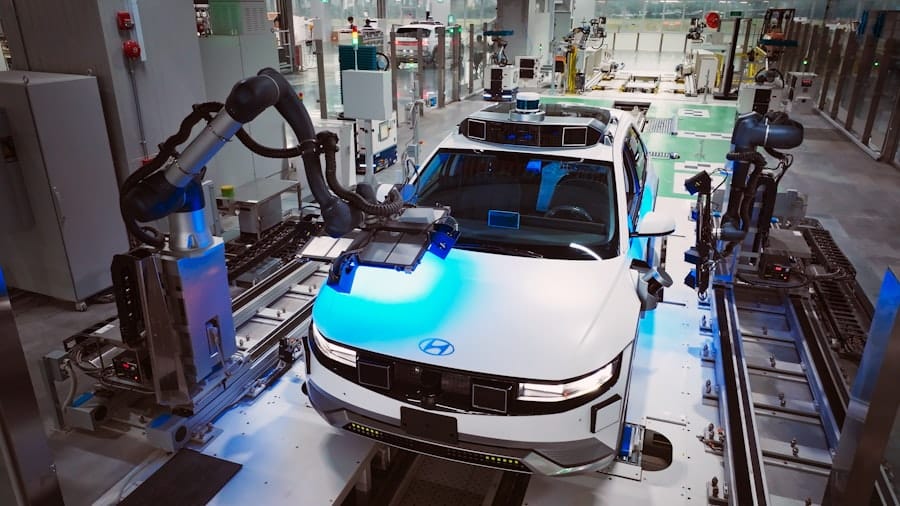The advent of robotics has ushered in a new era for high-risk manufacturing industries, where the stakes are often measured in human lives and significant financial investments. Industries such as mining, construction, chemical processing, and heavy manufacturing are characterized by hazardous working conditions, including exposure to toxic substances, extreme temperatures, and the potential for catastrophic accidents. In this context, robotics offers a transformative solution that not only enhances operational efficiency but also prioritizes worker safety.
The integration of robotic systems into these environments is not merely a trend; it represents a fundamental shift in how tasks are performed and how risks are managed. Robotics in high-risk manufacturing is not a one-size-fits-all solution. The technology encompasses a wide range of applications, from autonomous vehicles that transport materials in mines to robotic arms that handle dangerous chemicals in processing plants.
Each application is tailored to address specific challenges inherent in the industry. As companies increasingly recognize the potential of robotics to mitigate risks and improve productivity, the landscape of high-risk manufacturing is evolving rapidly. This article delves into the multifaceted role of robotics in these industries, exploring its impact on safety, efficiency, and overall operational dynamics.
Key Takeaways
- Robotics play a crucial role in improving safety and efficiency in high-risk manufacturing industries.
- Case studies have shown successful implementation of robotics in high-risk manufacturing environments, leading to improved safety and productivity.
- Challenges in integrating robotics in high-risk industries include cost, technical complexity, and workforce resistance, but solutions such as proper training and collaboration can address these issues.
- Robotics implementation in high-risk manufacturing has a positive impact on worker safety and job satisfaction, leading to a more engaged and productive workforce.
- A cost-benefit analysis of robotics implementation in high-risk manufacturing demonstrates the potential for significant long-term savings and improved operational performance.
The Role of Robotics in Improving Safety and Efficiency
Robotics plays a pivotal role in enhancing both safety and efficiency within high-risk manufacturing environments. By automating tasks that are traditionally performed by human workers, companies can significantly reduce the likelihood of accidents and injuries. For instance, in the mining sector, robotic systems can be deployed to perform drilling and blasting operations in hazardous underground environments.
These robots can operate in conditions that would be perilous for human workers, thereby minimizing exposure to dangerous gases, falling debris, and other risks associated with mining operations. Moreover, the efficiency gains from robotics are substantial. Automated systems can operate continuously without the need for breaks or shifts, leading to increased productivity.
In chemical processing plants, for example, robotic systems can handle the transfer of hazardous materials with precision and speed that far exceeds human capabilities. This not only accelerates production timelines but also ensures that processes are carried out consistently and accurately, reducing the risk of human error. The integration of robotics thus creates a dual benefit: enhanced safety for workers and improved operational efficiency for companies.
Case Study: Implementing Robotics in a High-Risk Manufacturing Environment

A compelling example of robotics implementation in a high-risk manufacturing environment can be found in the automotive industry, particularly in the assembly lines of major manufacturers like Ford and General Motors. These companies have adopted robotic systems to perform tasks such as welding, painting, and assembly—operations that involve exposure to hazardous materials and heavy machinery. By utilizing robotic arms equipped with advanced sensors and artificial intelligence, these manufacturers have been able to streamline their production processes while simultaneously enhancing worker safety.
In one notable case, Ford implemented a fleet of collaborative robots (cobots) on its assembly line. These cobots work alongside human operators, taking on repetitive and physically demanding tasks such as lifting heavy components or applying adhesives. The introduction of these robots not only reduced the physical strain on workers but also minimized the risk of workplace injuries associated with manual handling.
As a result, Ford reported a significant decrease in workplace accidents and an increase in overall productivity. This case illustrates how robotics can be effectively integrated into high-risk manufacturing environments to achieve both safety and efficiency goals.
Challenges and Solutions in Integrating Robotics in High-Risk Industries
Despite the clear advantages of robotics in high-risk manufacturing industries, several challenges must be addressed during the integration process. One major hurdle is the initial cost of implementing robotic systems. High-quality robots and the necessary infrastructure can require substantial investment, which may deter some companies from making the leap.
Additionally, there is often resistance from employees who may fear job displacement or lack confidence in working alongside automated systems. To overcome these challenges, companies can adopt a phased approach to integration.
Furthermore, investing in training programs for employees can alleviate fears about job security and enhance their skills in operating and maintaining robotic systems. By fostering a culture of collaboration between humans and robots, companies can create an environment where both parties contribute to improved safety and productivity.
Impact of Robotics on Worker Safety and Job Satisfaction
The impact of robotics on worker safety is profound, particularly in high-risk manufacturing environments where accidents can have dire consequences. By taking over dangerous tasks, robots significantly reduce the likelihood of injuries related to manual labor or exposure to hazardous materials. For instance, in chemical plants where workers are often required to handle toxic substances, robotic systems can be employed to manage these materials safely, allowing human workers to focus on oversight and monitoring roles that are less hazardous.
Beyond safety improvements, the introduction of robotics can also enhance job satisfaction among workers. When employees are relieved from performing monotonous or physically taxing tasks, they often find greater fulfillment in their roles. For example, workers at automotive assembly plants who previously spent hours performing repetitive tasks may now engage in more complex problem-solving activities or quality control processes thanks to the assistance of robots.
This shift not only boosts morale but also fosters a more skilled workforce capable of adapting to new technologies.
Cost-Benefit Analysis of Robotics Implementation in High-Risk Manufacturing

Conducting a cost-benefit analysis is essential for organizations considering the implementation of robotics in high-risk manufacturing settings. While the initial investment may be significant—encompassing costs related to purchasing robots, modifying existing infrastructure, and training personnel—the long-term benefits often outweigh these expenses. For instance, companies can realize substantial savings through reduced labor costs, decreased accident-related expenses, and improved operational efficiency.
A detailed analysis might reveal that while a robotic system requires an upfront investment of several hundred thousand dollars, it could lead to annual savings through reduced injury claims and increased production output that far exceed this initial cost over time. Additionally, as technology advances and becomes more affordable, the return on investment (ROI) for robotics is expected to improve further. Companies that strategically assess these factors can make informed decisions about integrating robotics into their operations.
Future Trends and Innovations in Robotics for High-Risk Industries
The future of robotics in high-risk manufacturing industries is poised for remarkable advancements driven by innovations in artificial intelligence (AI), machine learning, and sensor technology. One emerging trend is the development of autonomous mobile robots (AMRs) capable of navigating complex environments without human intervention.
Another promising innovation is the use of advanced sensors and data analytics to enhance robot performance. By equipping robots with sophisticated sensors that monitor environmental conditions and detect potential hazards, manufacturers can create systems that adapt to changing circumstances in real-time. This capability not only improves safety but also allows for more efficient operations as robots can optimize their performance based on current conditions.
The Potential of Robotics to Transform High-Risk Manufacturing Industries
The integration of robotics into high-risk manufacturing industries holds immense potential for transforming operational practices while prioritizing worker safety. As companies continue to embrace automation technologies, they will likely witness significant improvements in efficiency, productivity, and employee satisfaction. The challenges associated with implementing these systems are surmountable through strategic planning and investment in workforce training.
As we look ahead, it is clear that robotics will play an increasingly vital role in shaping the future landscape of high-risk manufacturing industries. With ongoing advancements in technology and a growing understanding of how to effectively integrate these systems into existing workflows, organizations stand poised to harness the full benefits of robotics—creating safer workplaces while driving innovation and growth within their sectors.
In the realm of high-risk manufacturing industries, robotics plays a crucial role in enhancing safety and efficiency. A related article that delves into the technological advancements aiding these industries is titled “Best Software for Fault Tree Analysis in 2023.” This article explores the latest software tools that are essential for identifying and mitigating potential faults in complex systems, which is a critical aspect of maintaining safety in environments where robotics are heavily utilized. For more insights, you can read the full article by following this link.
FAQs
What are the benefits of using robotics in high-risk manufacturing industries?
Robotics in high-risk manufacturing industries can improve safety by reducing the need for human workers to perform dangerous tasks. They can also increase efficiency, productivity, and quality of production.
How do robotics improve safety in high-risk manufacturing industries?
Robots can be used to handle hazardous materials, work in extreme temperatures, and perform repetitive tasks that may cause injury to human workers. This reduces the risk of accidents and injuries in the workplace.
What types of tasks can robots perform in high-risk manufacturing industries?
Robots can be programmed to perform a wide range of tasks, including welding, painting, assembly, material handling, and quality control. They can also be used for inspection and maintenance in hazardous environments.
What are the challenges of implementing robotics in high-risk manufacturing industries?
Challenges include the initial cost of investment, the need for specialized training for employees, and the potential for job displacement. Additionally, integrating robotics into existing manufacturing processes can be complex and require careful planning.
What industries can benefit from the use of robotics in high-risk manufacturing?
Industries such as automotive manufacturing, chemical processing, metalworking, and mining can benefit from the use of robotics to improve safety and efficiency in high-risk environments.

